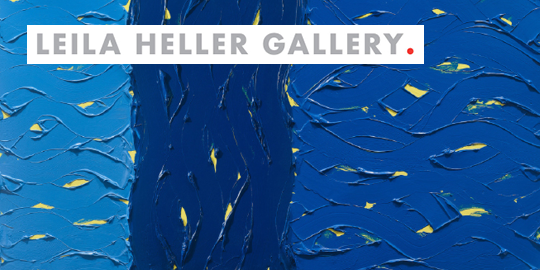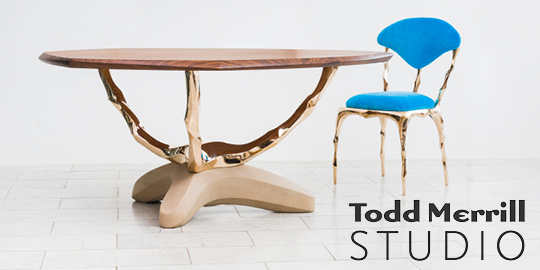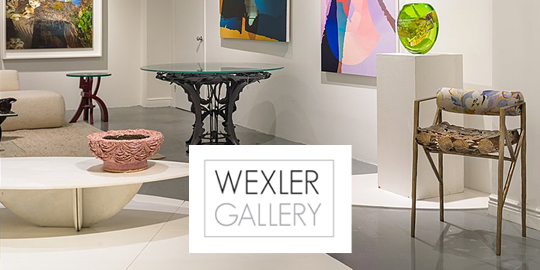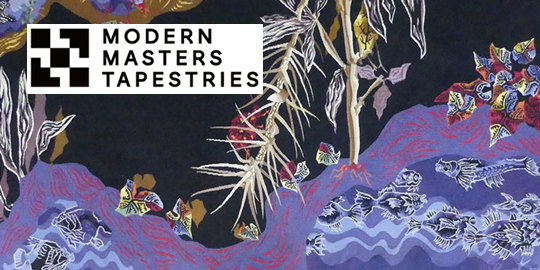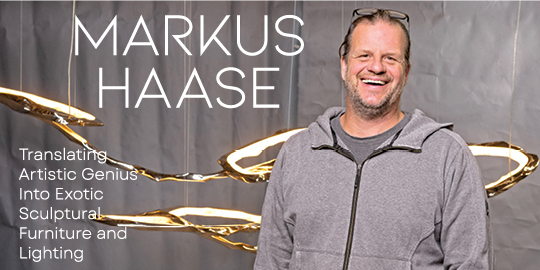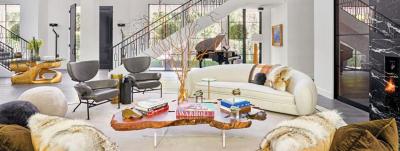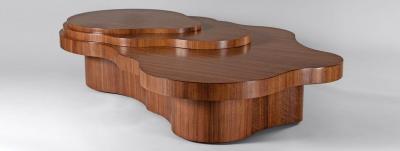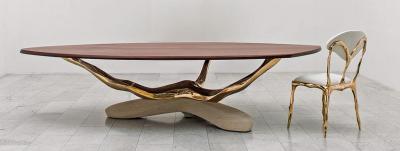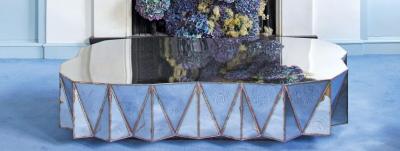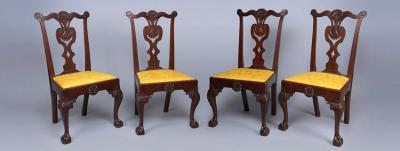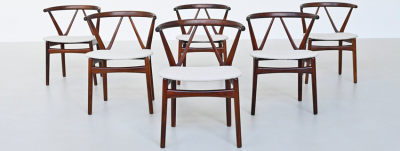Modern Classic: History and Modernity Converge in the Elegant Furniture Forms of T.H. Robsjohn-Gibbings
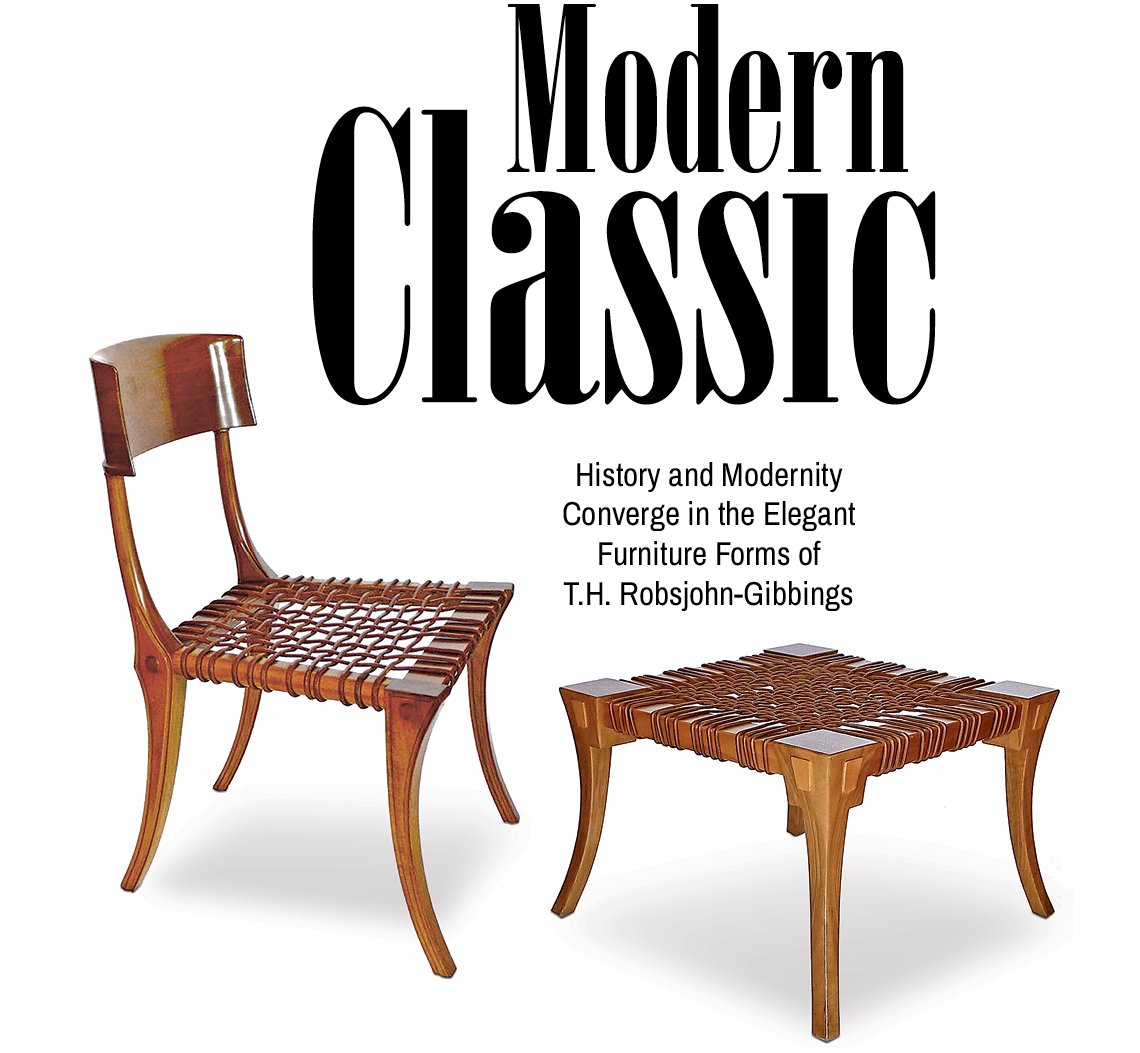 |
Original Klismos Chair and Stool/Table in Greek lacquered walnut and leather with sabre legs, 1st edition from 1961 produced by Saridis of Athens. Based on a 5th century BCE design. From TFTM on Incollect.com |
No one did more to shape modern American homes in the 1930s and 1940s than T.H. (Terence Harold) Robsjohn-Gibbings, a brilliant, often overlooked figure in the history of design. Born in Britain in 1905, Robsjohn-Gibbings studied architecture before landing a job with Charles Duveen, the influential London decorator and dealer in rare antiques and brother of the famous art dealer Lord Duveen. He moved to the United States to manage Duveen’s New York office but soon after opened his own shop on Madison Avenue. He found swift success as an interior designer and over the following decades designed interiors for top celebrities including Greta Garbo, Elizabeth Arden, Alfred Knopf, and Doris Duke.
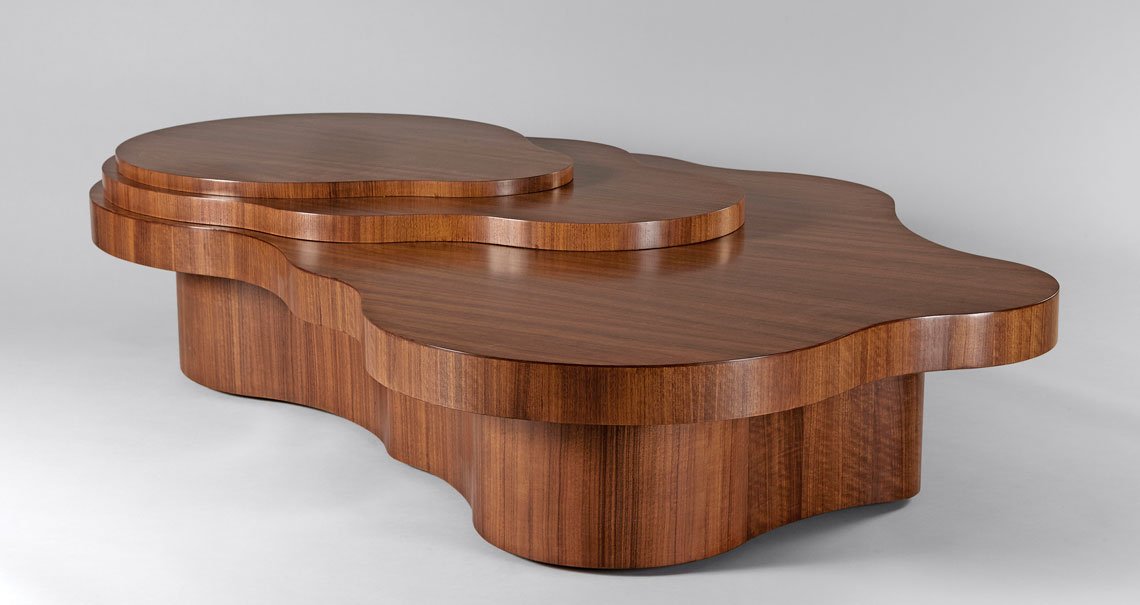 |
Mesa Table for Widdicomb, ca. 1952. Walnut. Released in a collection influenced by the American Southwest, this massive, freeform, three-tiered table measured 8' 9" × 6' 4." Photo courtesy of Donzella. |
Robsjohn-Gibbings was averse to prevailing taste among the American elite for 18th and 19th-century European furniture, which he viewed as anachronistic and unsuited to contemporary living. He embraced modern, more informal living and emphasized comfort and functionality over opulence and ornament. But unlike his modernist contemporaries, Charles Eames, Eero Saarinen, or Florence Knoll, for example, he disdained what he saw as the “sterile utilitarianism” of mid-century modern design and sought instead to mine classical Greek and Roman design principles for his creations. He pioneered the paradoxical idea of “modern classic” furniture and in this way eased the broader transition to modernism.
Robsjohn-Gibbings’ design philosophy can be summed up this way: he believed simplicity and elegance were the basis of beauty and a feeling of comfort and functionality in design — qualities that have made his furniture enduringly popular. He prized handmade and artisanal work over mass production, and favored natural materials such as wood, metal, and stone. His designs exude simplicity, clean lines and sweeping curved shapes, especially for chair or table legs, with subtle or no ornamentation beyond a preference for varnishes that dulled wood grains. He opposed angular forms and disdained the use of steel, glass, plastic and other new industrial materials that were favored in the work of many of his design contemporaries.
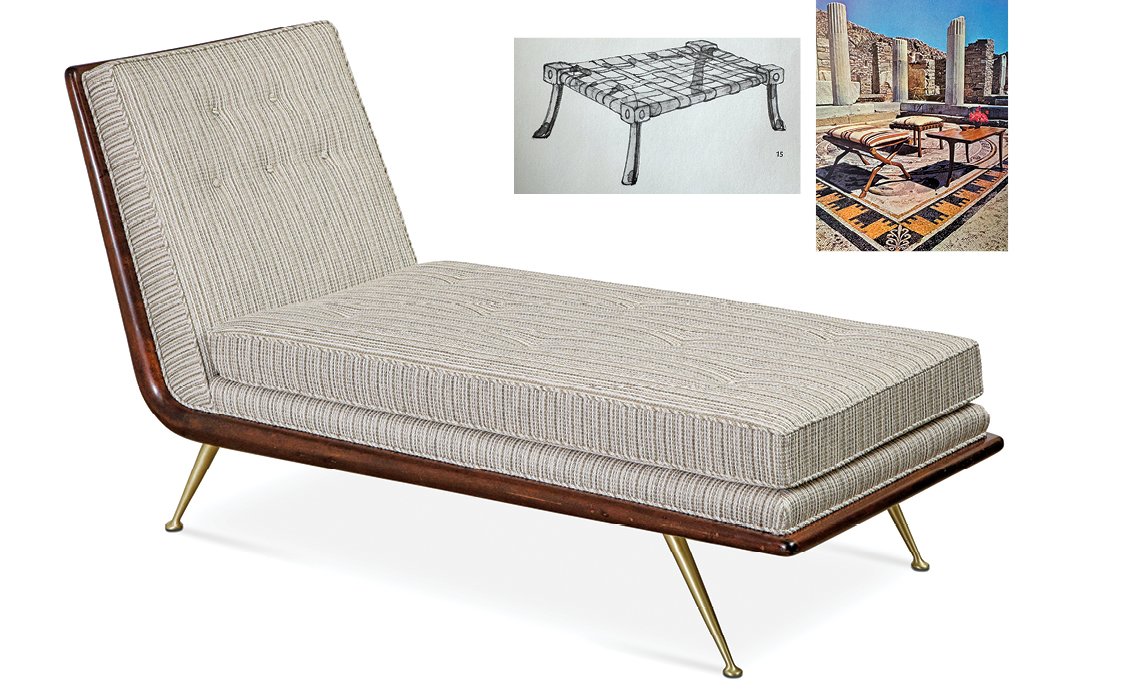 |
Dayrest Chaise with walnut frame and brass legs, Model 1729 produced by Widdicomb, United States, circa 1953. Photo courtesy of Donzella. Inset above left: Watercolor sketch of a classical Greek stool by Robsjohn-Gibbings. Inset above right: Furniture for the exhibition “Furniture of Classical Greece,” as photographed in the courtyard of the House of the Dolphins, ca. 110 BCE, on the island of Delos, photograph by Loomis Dean, courtesy TFTM. |
“He was a designer who looked back to move forward and that is what made him so great,” says Jake Baer, Chief Executive Officer of Newel based in New York. Baer, a lifelong fan of Robsjohn-Gibbings, is just one of many dealers and designers who have a near religious reverence for the designer. Among designs Baer admires are, he says, a Walnut Cocktail / Coffee Table with Magazine Box on top as well as Walnut Single Drawer Nightstands and a matching Walnut Six Drawer Chest of Drawers, all of which he describes as “simple, graceful and functional.”
Baer recently acquired a collection of 50 pieces of furniture by the designer, including examples of his iconic Klismos chairs, a take on traditional Greek klismos seats depicted on Greek classical vases. “These chairs are a stunning contemporary reinterpretation of an ancient Greek design, characterized by beautifully detailed, splayed legs,” he says. “What I admire most is their original leather cording and tags that showcase their exceptional craftsmanship and serve as a testament to quality.”
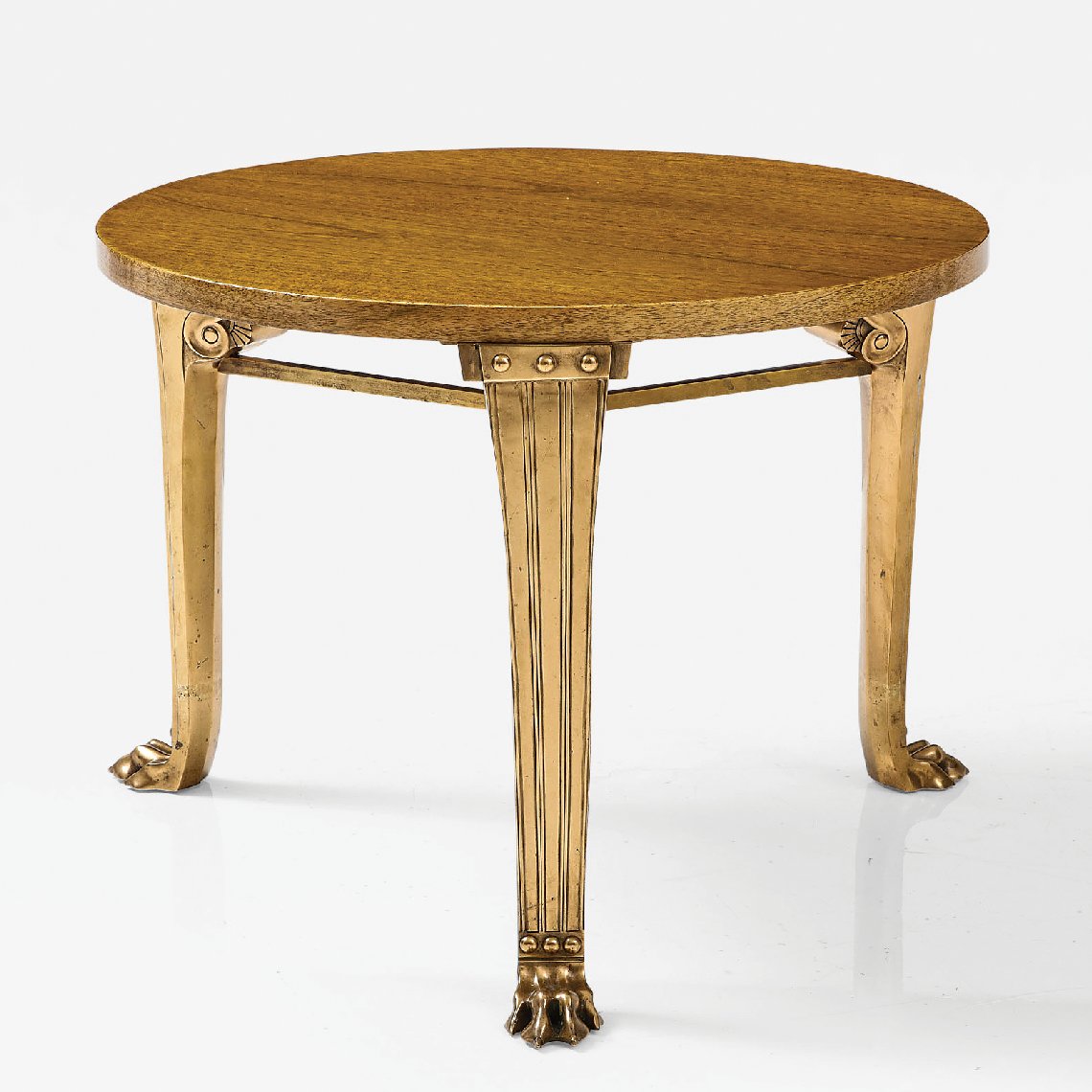 | 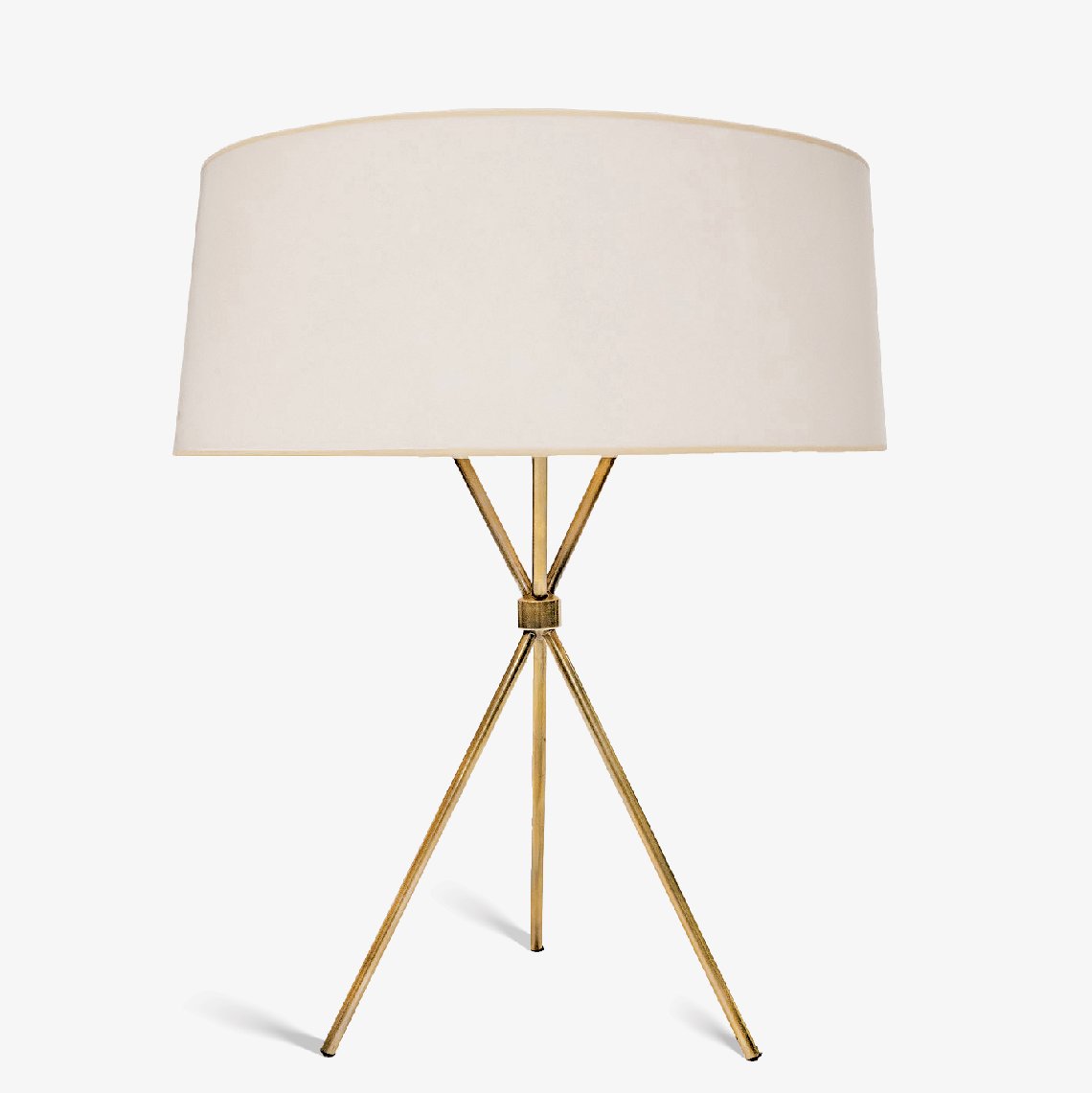 | |
| Left: ’Saridis” Tripod Table in walnut with cast and polished bronze base, produced by Saridis of Athens, circa 1960. From Lance Thompson Inc. on Incollect.com. Right: Brass Tripod Table Lamp, Model 170 for Hansen Lighting, United States, circa 1960s. From Lobel Modern on Incollect.com | ||
Robsjohn-Gibbing studied ancient Greek ceramics and vases in museums including the Metropolitan Museum of Art in New York, and sketched the furniture that was shown on them as an inspiration for his own furniture designs. “He also took notice of the fabric in designs that were on the ancient pieces of furniture he saw and he referenced these as well in his work,” says Maddie Sadofski from TFTM design gallery in Los Angeles, who has dealt in his material for more than two decades and is another dedicated fan. “He had this extraordinary ability to blend together the needs of modern life with these classical influences, and in the process made truly timeless forms that resonate today.”
One of Robsjohn-Gibbings celebrated quotes is that “a room should be a background for living,” and to this end his designs strive for an understated luxury, but with a strong attention to functionality, human proportion and scale. “His furniture designs were antiques-driven for sure, but he was really interested in how people were living at the time and how furniture could be updated to reflect new ways of living,” says Paul Donzella, who opened his first showroom in the East Village in New York in 1995 with an exhibition devoted to Robsjohn-Gibbings. “I was always drawn to him,” he says, “he was masterful in his proportions and such an elegant designer.”
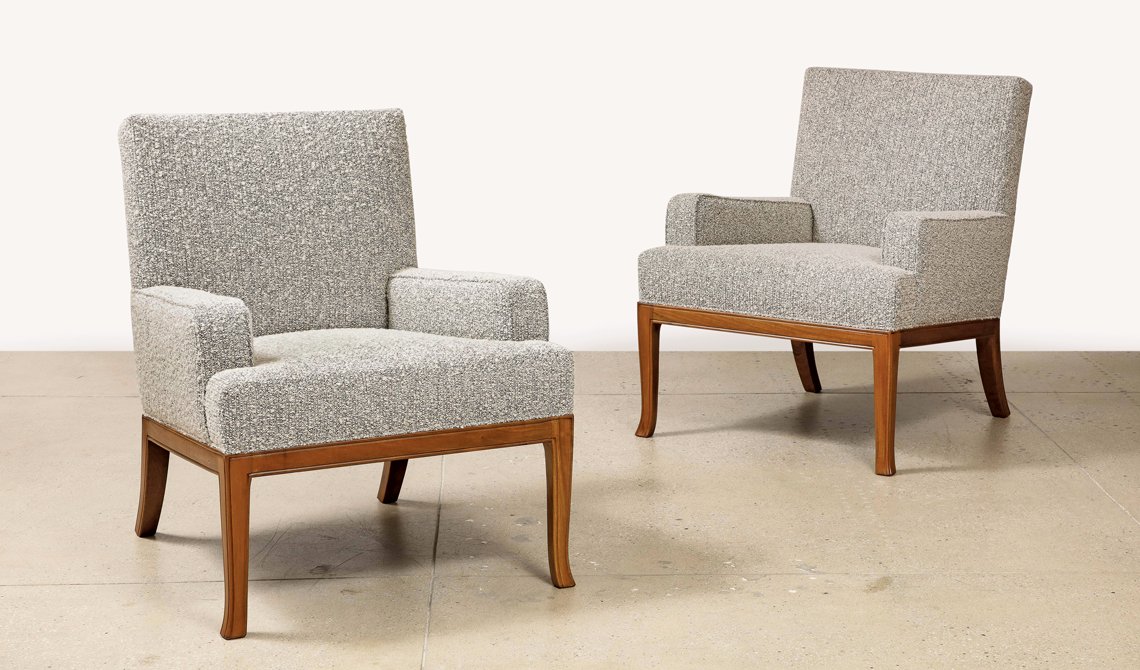 |
Lounge Chairs with walnut frames, Model 102 produced by Saridis of Athens, circa 1962. From Donzella on Incollect.com |
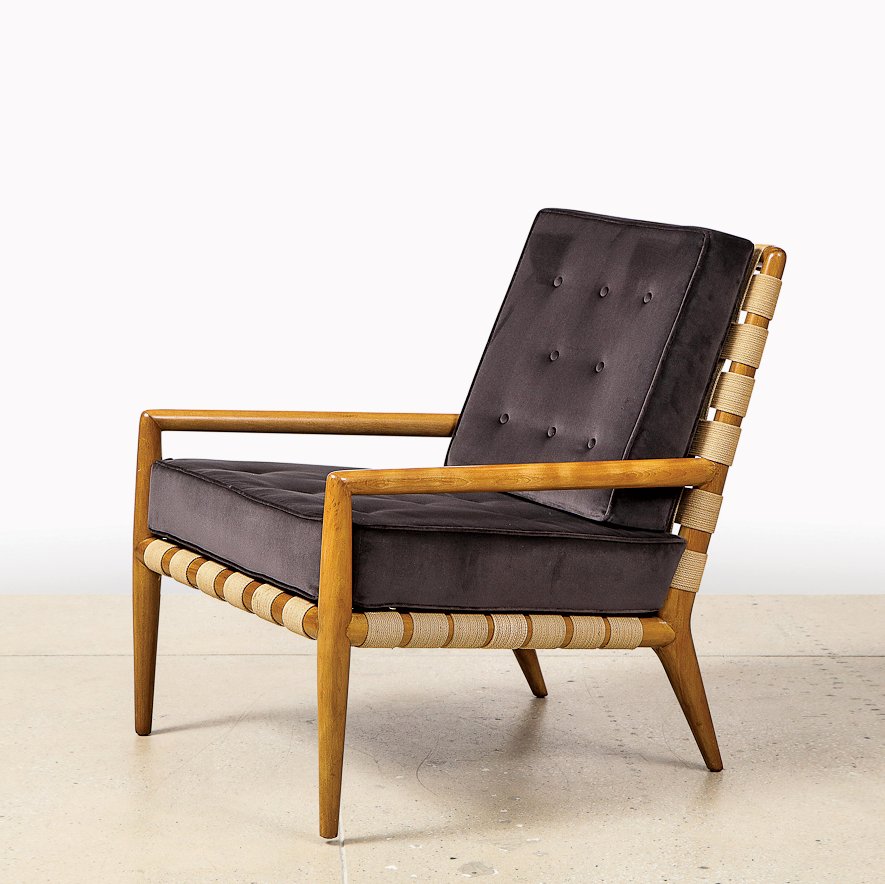 | 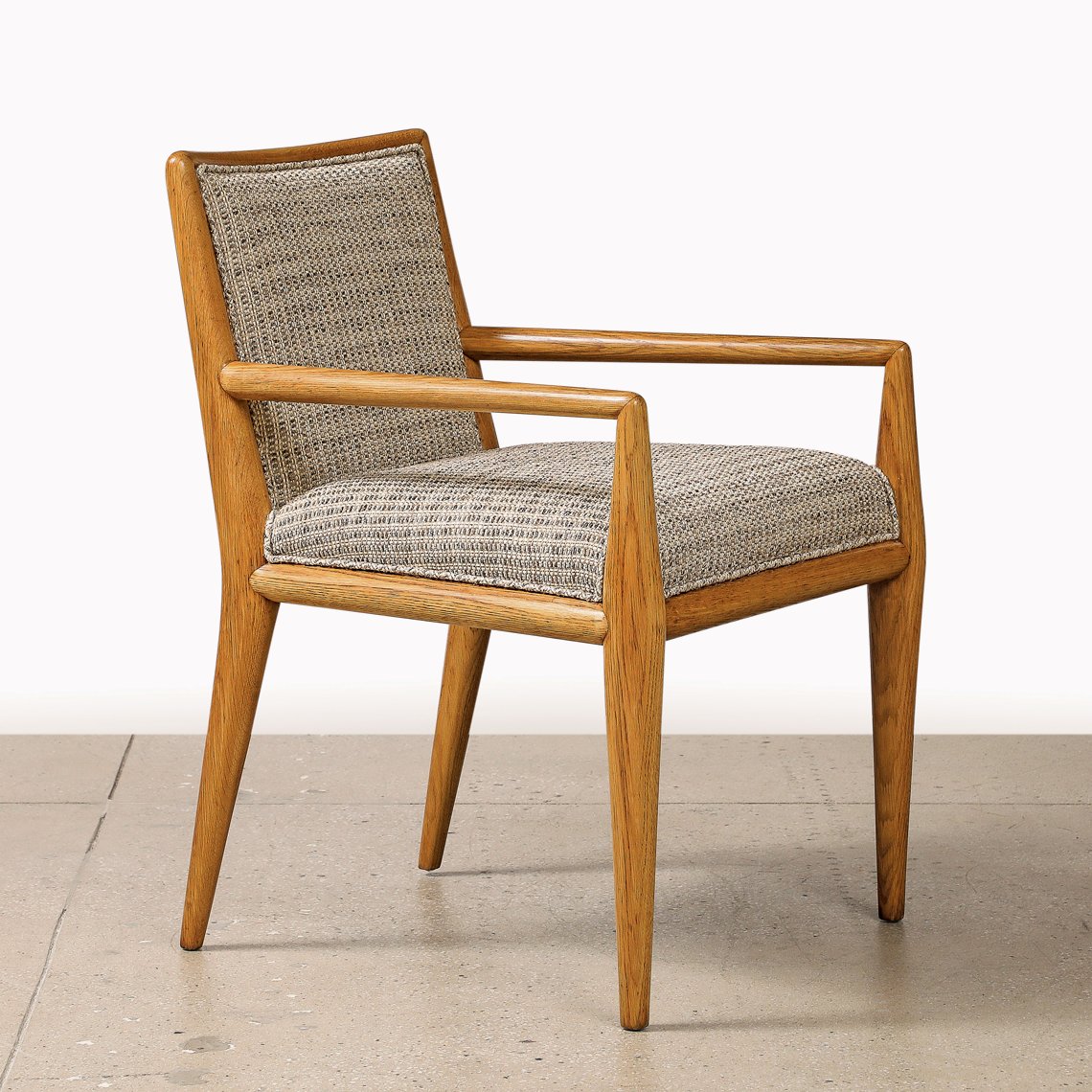 | |
Left: Lounge Chair in birch with woven canvas strapping, Model 1720 for Widdicomb, United States, circa 1950. Photo courtesy Donzella. Right: Open Arm Chair with oak frame, produced by Widdicomb, United States, circa 1946. From Donzella on Incollect.com | ||
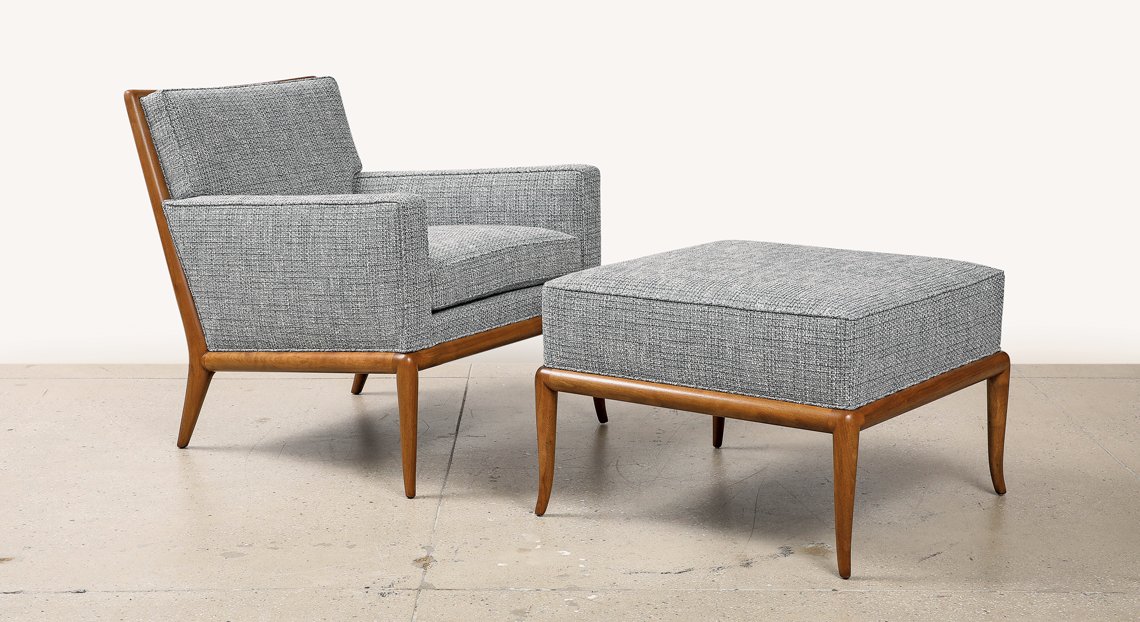 |
Lounge Chair and Ottoman with walnut frames, produce by Widdicomb, circa 1950. From Donzella on Incollect.com |
Pieces by Robsjohn-Gibbings adorn Donzella’s expansive showrooms at the New York Design Center alongside a roster of other major 20th-century designers. “I have favorite pieces by him,” he says, “things like the “Mesa” coffee table, the “Strap” sofa, or the “Siesta” chaise lounge and I buy them whenever I can.” Donzella says he just sold an armless sofa, a version of the classic chaise lounge introduced in 1954, to a private client in New York. “It was to a couple who came to the store and they instantly loved it. They are serious collectors, and appreciate its importance as a piece of design history,” he said.
Donzella believes Robsjohn-Gibbings is deserving of more market attention and recognition but notes that prices for his designs have increased substantially since he first started dealing in this material. The “Mesa” coffee table, inspired by the terraced, wind-and-water-eroded high desert mountain plains of the Southwest, designed for Widdicomb in 1951, is one of his most famous pieces of furniture. “The first ‘Mesa’ coffee table I ever had, in 1995, I sold for $10,000 and that was a pretty big number back then for a piece of 20th-century American design,” Donzella recalls. Today, original “Mesa” walnut coffee tables, from the early 1950s regularly sell for over $300,000 at auction, and one or two have sold for over $400,000.
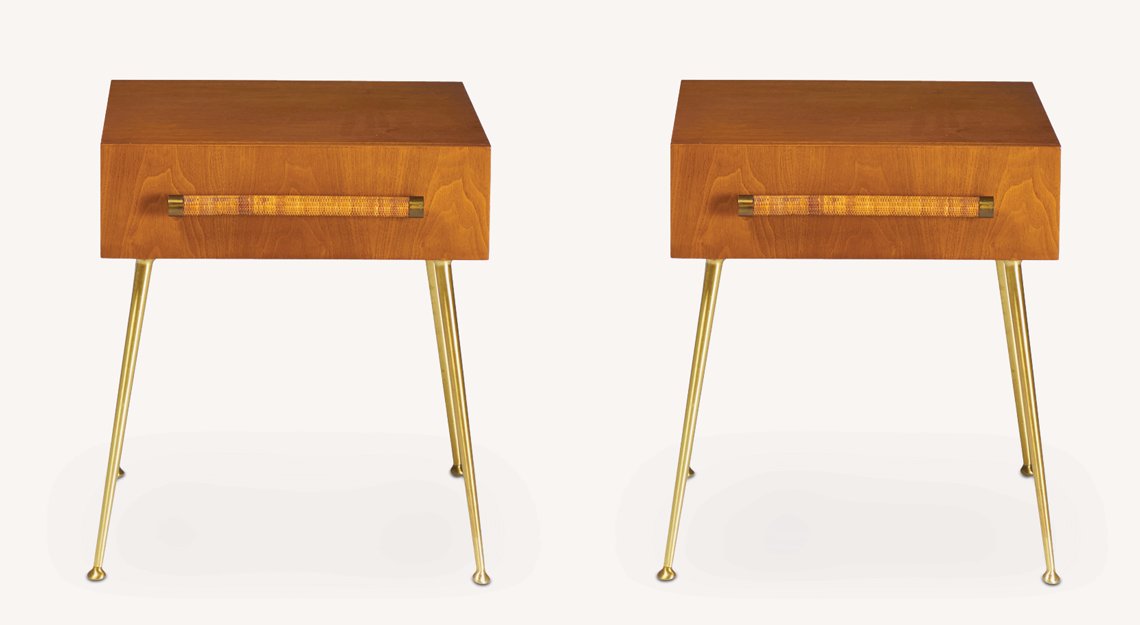 |
Side Tables/Nightstands in walnut with cane-wrapped dowel drawer pulls, tapered brass legs, produced by Widdicomb, circa 1960s. From Newel Antique Gallery on Incollect.com |
From 1943 to 1956, Robsjohn-Gibbings worked as a designer for the commercial furniture manufacturer Widdicomb Furniture Co. based in Grand Rapids, Mich. He designed many of his most popular furniture pieces for them including the “1759 Cocktail Table,” first introduced in 1948 and known as the Freeform coffee table because of its free-form, organic design reminiscent of a cloud. “It is a sculptural piece with a distinctive curvilinear shape and seemingly floating top,” says Lisa Staub, from Original in Berlin. “It is made from solid walnut wood and features a thick oval-shaped top that is supported by a series of brass legs that taper down to pointed feet. The legs are arranged in a triangular pattern, giving an overall sense of movement and fluidity. The effect is one of lightness and grace.”
Robsjohn-Gibbings’ many designs for Widdicomb remain his most accessible and in many ways enduring legacy — there is simply a lot more of it available on the market, though as with all vintage furniture the condition is everything. Among the most prized items are chairs and sofas with woven canvas webbing, such as his Lounge Chair, c. 1955, model 1720, made of bleached walnut and woven canvas webbing on offer at Converso. “His work always inspires me,” says Lawrence Converso. Prized also is his tripod table lamp, model 170, in brass with three bulbs and shade for Hansen Lighting from the 1960s. “This lamp is a timeless mid-century design classic,” says Evan Lobel, who occasionally deals in the designer’s material.
 |
Coffee Table with removable magazine box in walnut, produced by Widdicomb, United States, circa 1960s. From Newel Antique Gallery on Incollect.com |
Robsjohn-Gibbings spent much of his later career designing items for Widdicomb and other commercial manufacturers as part of a commitment to democratizing design — something he wrote about in several influential books on design and art that established him as a tastemaker. But his true sensibility as a designer probably achieved its purest expression in his private client projects, such as the early commission to furnish Hilda Boldt Weber's sprawling sixty-four room mega-mansion Casa Encantada in the Bel Air neighborhood of Los Angeles, for which he designed more than 200 pieces of furniture and decorative art.
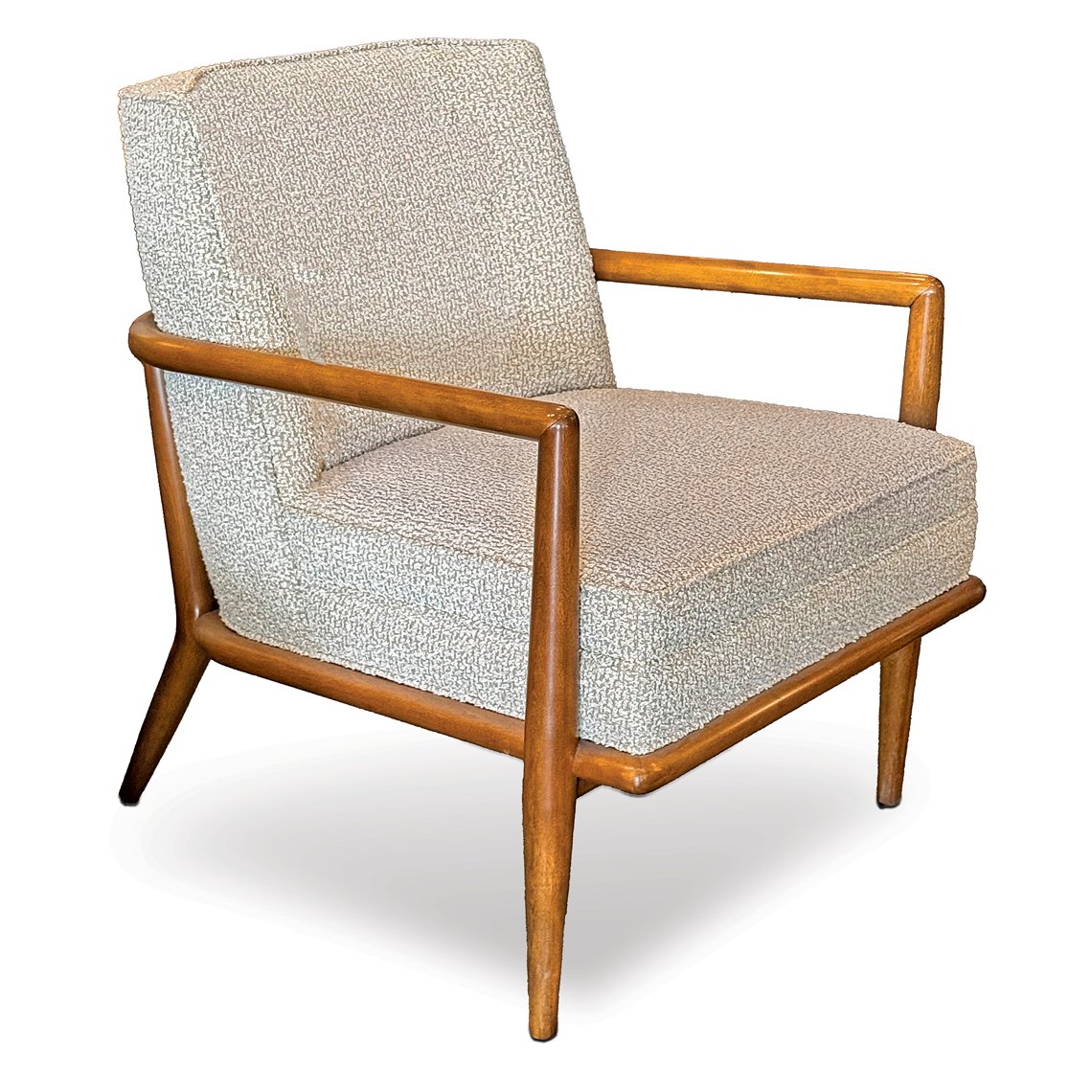 | 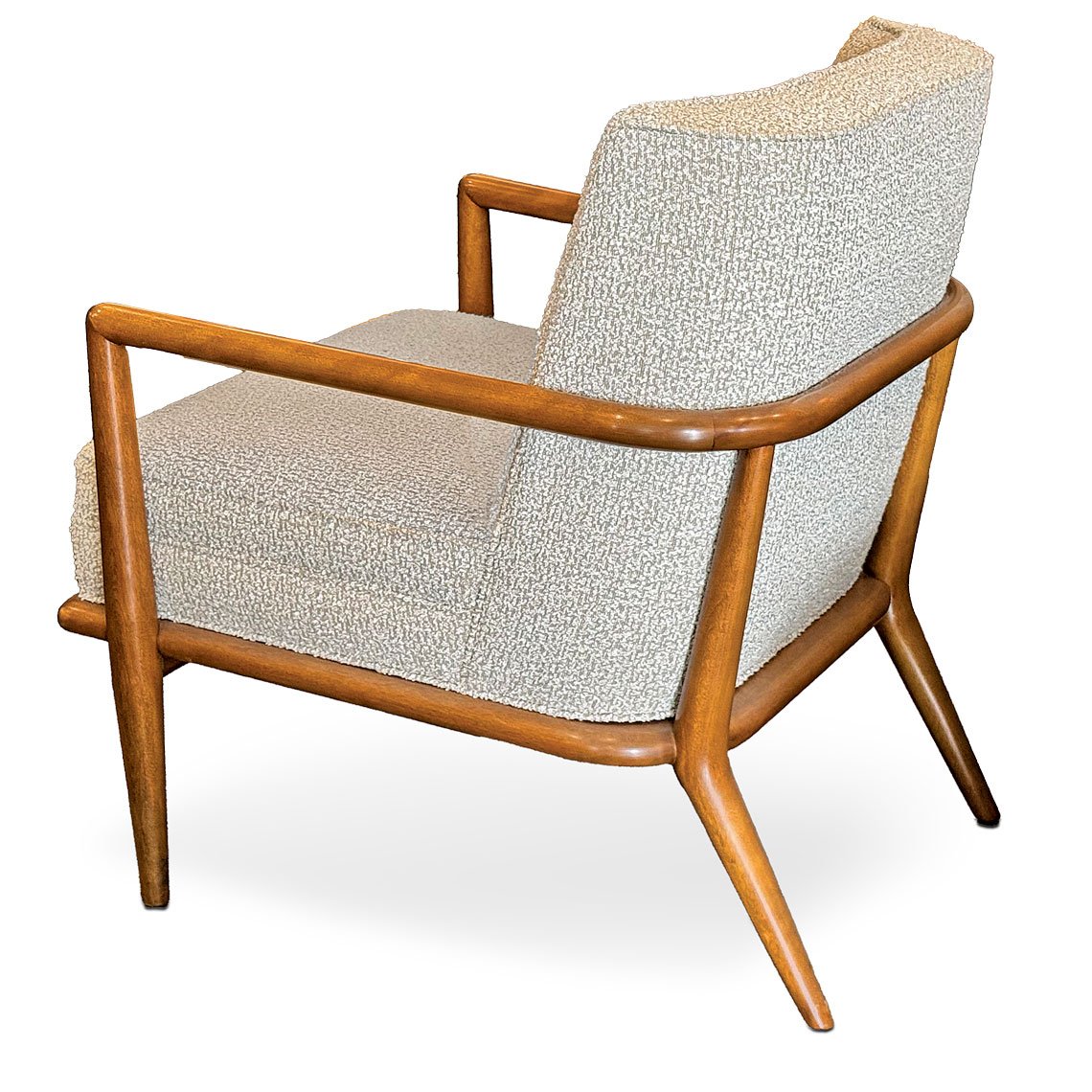 | |
Curved Back Tub Chairs in walnut, produced by Widdicomb, United States, circa 1940s. From TFTM on Incollect.com | ||
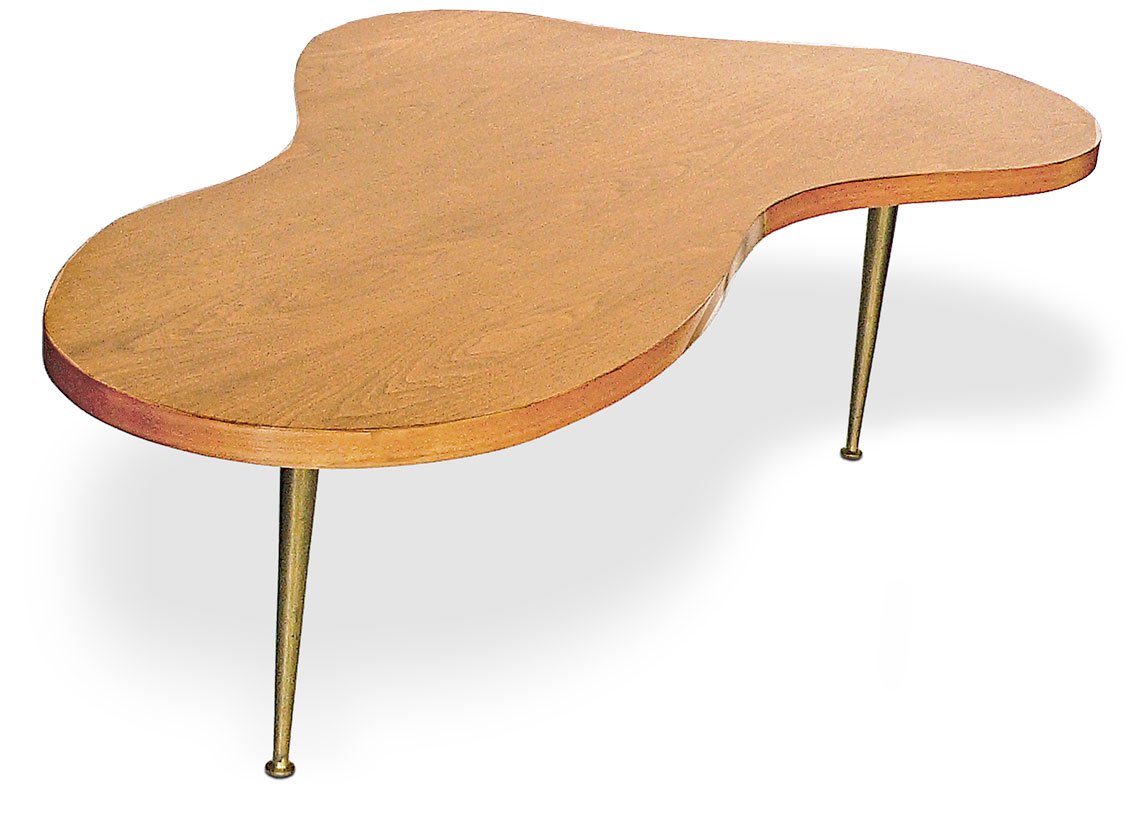 | |
Freeform Coffee Table in birch with three brass legs, Model 1759 produced by Widdicomb, United States, 1954. From TFTM on Incollect.com |
Today Casa Encantada is one of the most famous residential structures in Los Angeles — valued somewhere between $100 and $200 million dollars. It has been remodeled many times, most recently with a do-over by Peter Marino inspired by the original Robsjohn-Gibbings interior, completed between 1934 and 1938. Robsjohn-Gibbings decorated the home in Art Deco style, modern and luxurious with an attention to simple, graceful lines and fine materials. Photographs of the original interior reveal that he drew heavily on classical forms and iconography for inspiration — imagery of sphinxes, birds, dolphins and Grecian columns were freely incorporated into table bases, sofas, vases and chairs, giving the interior an elegant and clearly historical, Hellenic appearance.
Robsjohn-Gibbings dedication to the vocabulary of the classical world had largely fallen out of fashion following his emigration to Greece in 1967, where he became the personal interior designer to Aristotle Onassis. His final series of designs was made by artisanal furniture makers Susan and Eleftherios Saridis of Athens, with whom he created a Klismos line of furniture, including the Klismos Chair which is still in production today. His designs for Saridis reprise classical forms, such as his ‘Saridis’ walnut table, a graceful design with bronzed claw base, from circa 1960, that dealer Lance Thompson bought from a client. “The tripod table form for furniture goes back to ancient Egypt, but in this case is updated with a simplified wooden top to highlight the decorative legs,” Thompson says. “Though classically influenced his designs are always informal and livable and for that reason, remain timeless.”


